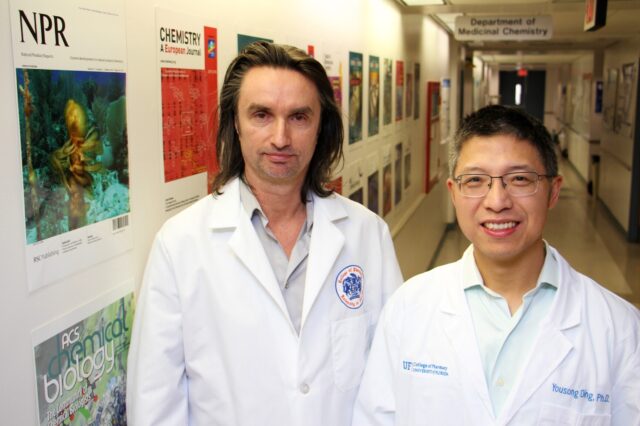Decoding the genes behind dolastatin 10 paves the way for new cancer therapeutics

Hendrik Luesch, Ph.D., and Yousong Ding, Ph.D., co-authored the study that identified the genes responsible for producing dolastatin 10.
University of Florida College of Pharmacy researchers have pinpointed the genetic blueprints behind dolastatin 10, a marine natural product that has led to six FDA-approved cancer drugs since 2011. The discovery could unlock the potential for new cancer therapeutics.
In a study published Feb. 8 in the journal Organic Letters, UF researchers outline how they used a combination of genomic library screening and genome sequencing to identify the genes responsible for producing dolastatin 10. Successful gene identification marks a noteworthy advance in understanding the compound and lays the groundwork for developing future medicines.
“Now that we understand the genetics and the machinery involved in creating this molecule, we can envision genetic manipulations and synthetic biology approaches to produce these types of compounds in the future,” said Hendrik Luesch, Ph.D., a professor and chair of medicinal chemistry and the Debbie and Sylvia DeSantis Chair in Natural Products Drug Discovery and Development in the UF College of Pharmacy. “Dolastatin 10 stands out as the most successful marine natural product to date. With six FDA-approved cancer drugs and over 100 ongoing clinical trials featuring this compound’s derivatives, there is significant interest in continually investigating its clinical possibilities.”
Efforts have been made over time to enhance the drug-like characteristics of dolastatin 10. Despite its initial limitations due to high toxicity, the advent of a novel technology known as antibody-drug conjugation has significantly expanded the use of dolastatin 10’s synthetic analogs in cancer therapy development. When the analog is linked to an antibody, tumor cells can be targeted specifically. This innovative approach has led the FDA to approve multiple antibody-drug conjugates, demonstrating their efficacy as anticancer drugs for various lymphomas, bladder and other types of cancer.
As a graduate student in 2001, Luesch published the first scientific paper linking dolastatin 10 to marine cyanobacteria, or blue-green algae, collected from the Pacific Ocean. Since then, his research team has spent more than two decades collecting and analyzing cyanobacteria around the world with his collaborator Valerie Paul, Ph.D., from the Smithsonian Marine Station in Fort Pierce, Florida. The samples used in the latest study were harvested in the tropical waters of the Florida Keys.
“Identifying the genes responsible for dolastatin 10’s production offers conclusive evidence that this compound originates from cyanobacteria,” said Luesch, who also directs the UF Center for Natural Products, Drug Discovery and Development, or CNPD3 and is a member of the UF Health Cancer Center. “We have identified cyanobacteria that have proven to be extremely productive in generating drug leads in diverse oceanic regions. Below the ocean’s surface are many untapped resources holding the potential for new drug development, and our pipeline of promising compounds for various diseases — including cancer — continues to grow.”
UF scientists devoted years to studying the biosynthesis of dolastatin 10. Much of the effort was led by CNPD3 researchers who have developed a platform examining unexplored marine organisms and the associated genes and molecules that can lead to successful drugs.
“There are many different cyanobacteria available in the world’s oceans,” said Yousong Ding, Ph.D., an associate professor in the UF College of Pharmacy and the associate director for synthetic biology in the CNPD3. “From each cyanobacterial genome, we can expect 30 different molecules on the genetic level. This platform gives us the tools to find other molecules on the genetic level and support their production using synthetic biology approaches. We will eventually create an extensive novel natural product library for drug research.”
In 2022, the National Institute of General Medical Sciences awarded a $8.8 million grant to Luesch, Ding and a multidisciplinary team of collaborators to address limitations in natural product drug discovery. The funding has advanced research involving the biosynthesis of dolastatin 10 and supported the discovery of other noteworthy genes in future drug development.
The faculty co-authors of the Organic Letters publication included Luesch, Ding, Paul and Steven Bruner, Ph.D., a professor of chemistry at UF, and their team members.
About the author
